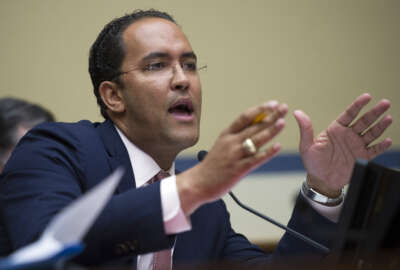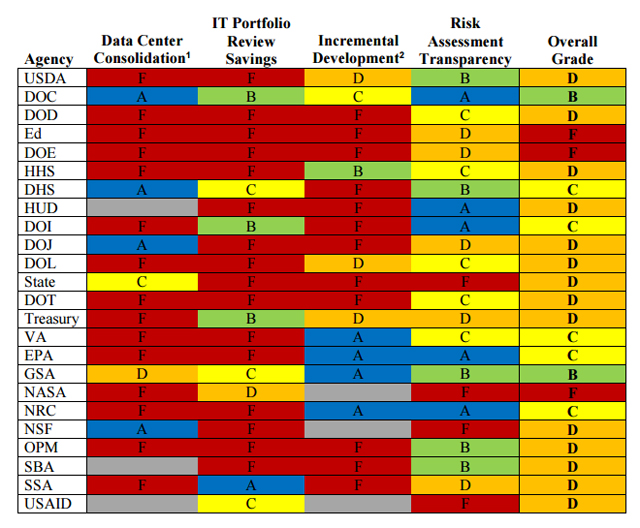
Agencies warned to begin improving IT reform efforts
The House Oversight and Government Reform Committee released the Federal IT Acquisition Reform Act scorecard and the governmentwide average is a “D.” Lawmakers...
The first federal report card on the Federal IT Acquisition Reform Act shouldn’t be considered a “scarlet letter” for the majority of agencies that didn’t do well.
The governmentwide average of a “D” should instead be looked at as a floor where every agency should plan to climb up from.
The House Oversight and Government Reform Committee released the FITARA scorecard Wednesday in what is expected to be the first of several hearings on agency progress toward implementing the year-old law.
“This scorecard is not intended to be a juridical, prescriptive exercise,” said Rep. Gerry Connolly (D-Va.), the ranking member of the government operations subcommittee and co-author of FITARA. “It is an initial assessment, a point in time snapshot, much like quarterly report card one might get in a university or school. The intent isn’t to punish or stigmatize. It is, in fact, to exhort and urge agencies to seize this opportunity, and use the scorecard as a management tool to better guide decision making and investments within the agency. While the grades themselves are illustrative of overall performance, it is the multiple elements that make up the grades on which agencies and our committee will focus to ensure we deliver on the transformative promise of FITARA.”

The committee scored agencies across four of the seven areas of FITARA. Lawmakers reviewed agency progress against their data center consolidation plans, IT portfolio reviews using the PortfolioStat tool, risk assessment of IT projects, and CIO authorities to move agencies toward incremental or agile development for IT projects.
The committee brought those four grades together for a final score. Across all five metrics, agencies earned a total of 14 “A’s” out of 120 total grades.
Overall, the Department of Commerce and the General Services Administration garnered the highest overall grades with “B’s.”
Only the departments of Education and Energy, and NASA received “F’s” for their overall grades, while a majority of agencies received overall grades of “D.”
Rep. Will Hurd (R-Texas), the chairman of the IT subcommittee, which held the FITARA hearing on Wednesday and released the scorecard, said while no agency received a gold star, he did see some agencies making real progress against these four IT improvement goals.
This theme of the scorecard being a floor was lost on those who testified.
Tony Scott, the federal CIO, said he only saw the scorecard for the first time on Wednesday.
“One of the ways to look at it is it’s a baseline of where we are today. I think the hope for FITARA is to seize this historic moment and frankly do things differently than we’ve done in the past,” he said. “To me, the real measure will be six months or a year from now, did we really move the needle on these things? I would love to change the past. I can’t do that, but haven’t figured out a way. If we can really make progress in the next year or two, I think that’s the real test. Hopefully, the scorecard can reflect real-time progress as we go down the road. As we work together, I’d like to figure out how to make sure we are getting more real time visibility.”
Lawmakers from both sides of the aisle reiterated Scott’s hope for progress. But Hurd said if the committee doesn’t see improvements over the coming months, then they will have more uncomfortable conversations with agency CIOs and other leaders.
Hurd and Connolly also made it clear that exemptions or carve outs, such as what the National Laboratories at the Energy Department are trying to do, and compliance-only efforts will not be tolerated.
Data center consolidation seen as ‘big dollar savings area’
While the committee wants improvement across the all scorecard metrics, the one area both lawmakers and the Government Accountability Office kept coming back to during the hearing was data center consolidation.
GAO’s David Powner, the director of IT management issues, said agencies are leaving billions of dollars in savings and cost avoidance on the table.
“This is the big dollar savings areas. FITARA requires annual publicly reported updates on savings. Our ongoing review for this committee highlights the importance of this section of the law,” he said. “Twenty-one hundred more data centers are now being reported to us for a total of 11,700 centers. Over 3,300 have been closed to date, and the government plans to close an additional 2,000 centers. Over $2.5 billion have been saved and there is another $5.5 billion on the table,” he said. “So in total, the government plans to close about 5,000 centers and save about $8 billion. Mr. Chairman, this $8 billion total actually should be much higher since some agencies have low-balled their targets, and not all have new cost estimates in.”
Powner said the departments of Commerce, Defense, Homeland Security, Transportation and Treasury have done the best job in achieving savings from consolidating data centers.
Over the next few months, OMB is expected to issue policy to further define what agencies need to do in 2016 and beyond to close more data centers. Powner said the guidance will look at core and non-core data centers, and expectations for them both.
Certain agencies need more of a push from OMB and Congress to take this initiative more seriously, he said.
Spend a little money to save a lot of money
But one of the big challenges with data center consolidation, as with many of the FITARA initiatives, is the need to spend a little bit of money to save a lot of money.
Several lawmakers asked the CIOs who testified if some sort of incentive to save money and invest it back into the IT infrastructure and mission area is needed.
Transportation CIO Richard McKinney said creating some sort of way for agencies to save money, especially as they consolidate data centers, is important. He said data centers are the foundational piece of all IT infrastructure.
“It’s like you have an old house, where do you go? The basement. I’m headed in to the basement trying to figure out what’s the foundation? What’s the plumbing, what’s the electrical like? And I’m trying to fix that out first,” he said. “I think most of the money, the savings, is in that. But I also think it’s absolutely essential if we are doing to build great IT on top of it.”
Rep. Mark Meadows (R-N.C.) said he supports an approach to give agencies a way to keep savings.
“If any of you or all of you want to work with us in terms of being more aggressive in terms of data center consolidation and those big numbers, I’ll work in a bipartisan way with my colleagues to go to the appropriators and say, ‘Listen we need to give them the benefit of the doubt,’ whether that’s on the authorizing side, certainly on the appropriating side to see what we can do” to make sure agency budgets are not reduced if they cut their data center costs,” Meadows said.
McKinney said the goal is not only to drive down costs, but improve service delivery. But both cost money upfront, which is why agencies need help from Congress.
Hurd said the committee plans to update agency progress against these metrics quarterly. GAO also is in the midst of several studies looking at different aspects covered in the scorecard.
Related Stories

OMB expects ‘believable plans’ from agencies as FITARA deadline nears
In the meantime, agencies must finalize their FITARA implementation plans by Dec. 31 and publish them online.
Scott said that is one of several ways OMB is making sure this effort is anything but a rubber stamp event.
He said OMB is taking several steps to hold agencies accountable over the short and long term.
“We have a number of these OMB guidelines coming out,” Scott said. “I think the development of the appropriate scorecards and measure in that space will help us measure progress in that area, and continuing to insist that IT spend be identified as a part of major projects and getting the visibility of that at all levels, whether it’s at the sub-agency level or at the agency level is super important. Another one to me is that as we plan and budget for things, that conversation that takes place among the senior leadership, the CXO, the program heads, and so on, clearly identifies what the expectations are of IT in that particular case is absolutely one of the keys.”
Scott added OMB also is relaunching management.cio.gov to list best practices and agency implementation plans. OMB also is working closely with the CIO Council, the President’s Management Council and GSA to further information sharing.
Hurd said that there may be a need for a hearing where not just CIOs, but CFOs, chief acquisition officers and chief human capital officers testify about their role in implementing FITARA.
Copyright © 2025 Federal News Network. All rights reserved. This website is not intended for users located within the European Economic Area.
Jason Miller is executive editor of Federal News Network and directs news coverage on the people, policy and programs of the federal government.
Follow @jmillerWFED




